project management lecture 2
Software Project Management-Chap2A-2012
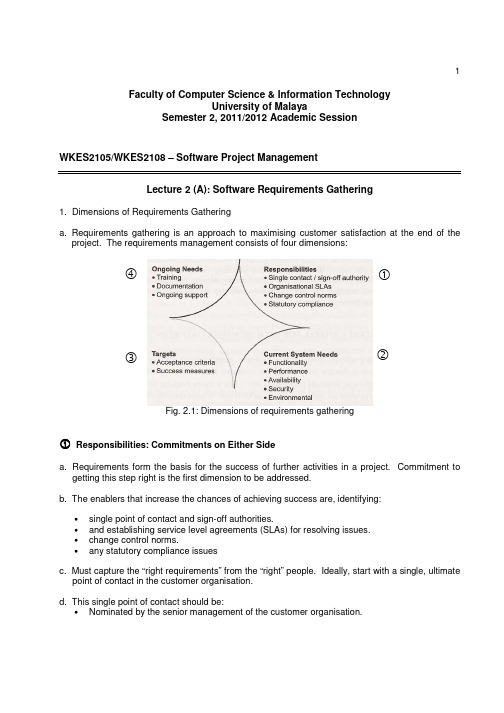
Faculty of Computer Science & Information Technology University of Malaya Semester 2, 2011/2012 Academic Session WKES2105/WKES2108 – Software Project ManagementLecture 2 (A): Software Requirements Gathering1. Dimensions of Requirements Gathering a. Requirements gathering is an approach to maximising customer satisfaction at the end of the project. The requirements management consists of four dimensions:Fig. 2.1: Dimensions of requirements gathering Responsibilities: Commitments on Either Side a. Requirements form the basis for the success of further activities in a project. Commitment to getting this step right is the first dimension to be addressed. b. The enablers that increase the chances of achieving success are, identifying:• single point of contact and sign-off authorities.• and establishing service level agreements (SLAs) for resolving issues.• change control norms.• any statutory compliance issues c. Must capture the “right requirements” from the “right” people. Ideally, start with a single, ultimate point of contact in the customer organisation. d. This single point of contact should be:• Nominated by the senior management of the customer organisation.•Officially notified to all team members.e. Typically, the single point of contact is the Head, Information Systems or Chief InformationOfficer so that a sense of legitimacy and authority is brought to the table.f. The single point of contact:•Represents the big picture: He knows the complete requirements of the organisaton, articulates the needs, knows what the various components of the system are and how they fit together.•Nominates other contacts for more details: He nominates the module owners who can give specific details of the individual components.•Acts as a tie-breaker in the case of conflicts: When multiple components are involved, it is possible that they will have conflicting requirements. He acts as a tie-breaker and an arbitrator (judge) in issues. His ruling is final.•Prioritises the various requirements: He decides which requirements should take precedence.g. It may not be possible for the single point of contact to get into all the details of all thecomponents. E.g., if the system to be developed is an Integrated Human Resources System (HRS), the single point of contact should be able to state at a high level that the system should take care of personnel management, payroll and training. The owners of each of these modules could be the HR, finance, and training departments.h. During requirements gathering, two things would happen:i. There are bound to be certain unclear or conflicting issues that need clarification from thecustomer. Service Level Agreements (SLAs) address the response time to queries for resolving any conflicts. These include response to questions like, “How long would the single point of contact take to resolve conflicts?”ii. Even the requirements are agreed upon initially, they are found to change later on.Change is unavoidable, it has to be anticipated and managed by appropriate Change-control norms. Change-control addresses procedures to request, identify, and evaluate changes in requirements. During the requirements phase, when the system definition is still evolving, changes will take place almost continually. Using the sign-off authorities and single point of contact, such changes can be aggregated and consolidated.i. A customer organisation may have statutory processes that may have to be followed (e.g.auditable under ISO 9001, CMM, etc.). Such compliance requirements are not compromisable and should be identified upfront. They form the foundation of the entire requirements management process.Current System Needsa. To gather the actual basic needs which should be satisfied by the software product.b. The needs are classified into:i. Functionality RequirementsThis part addresses issues like: what is expected from the system and how the system would satisfy the business needs of the customer. Some of the aspects are:•What are the modules (or sub-components) that make up the system?•What are the inputs and outputs of each module?•What is the data that is maintained by the system?•Are there any external industry standards that the product should adhere to?•What are the interfaces between the modules?These functionality requirements translate into prioritised feature lists which identify the various features required in the product and the relative priorities for each of these features.ii. Performance RequirementsThis part specifies the traffic that an application is expected to satisfy. Some of the parameters to be gathered are:•Data storage requirements.•Maximum number of users expected on the system.•Peak load that can be expected on the system in terms of transaction.•Expected response time for transactions.Performance requirements are tough to quantify especially for applications based on the Internet.iii. Availability NeedsThis part is about the up-time expected of the various components. Some of the factors that up-time expectations dictate include:•Amount of redundancy to be built into the system (both at hardware and software levels).•Sophistication of the underlying tools like databases.•Operational issues like scheduling of back-ups.iv. SecurityThis part determines who can have access to which parts of the system and at what times. Some of the issues addressed are:•Who are the authorised users of the system?•How are they authenticated?•What access rights does each of the users have on various business components (e.g.modules, inputs, outputs, etc.)?•Who is authorised to administer these security rights?v. Environmental DefinitionThis part specifies any constraints with regard to the hardware and software platforms that the system should run on. As the choice of the hardware / software platforms greatly influences the design and further development, as well as the eventual performance of the systems and also (to some extent) dictates the skill sets needed.TargetsThese consist of:i. Success measuresThis denotes the criteria under which the project can be deemed successful. There are some targets that can be negotiated and compromised on and some that have to be absolutely met because of business realities. Examples:•Are there any drop-dead dates on completion?•Is there a limit on the budget for the project?•Is there a restriction on the number of people you can deploy on the project?ii. Acceptance criteriaWhen a system is developed, how can one conclude that it meets the needs of the customer? Acceptance test criteria are meant to serve this purpose and it is characterised by:•It is specified early in the development cycle (during the requirements phase).•It is set forth by the customer, to reflect the real life use of the product.•It uses the data from the customer’s environment and not the test data generated by the software development organisation.•It covers all aspects of requirements (i.e., functionality, performance, security, availability, and environment).Ongoing NeedsWhen requirements for a software product are drawn up during the requirements management phase, it is important to consider the non-software aspects of the product that the customer would need for successful deployment of the product. These include:i. DocumentationEvery product requires documentation and the extent to which it is needed depends on the complexity of the product and what has been agreed upon. Examples of documentation required are:•User manuals•Requirements specification•Design documentation•Installation guides•On-line helpii. TrainingOnce a product is developed, its users may need to be trained in how to use it. There could be different levels of training for different people. Examples:•Users may need training on the modules they would be using (e.g. data entry forms, menus, reports, etc.).•System administrators need training on providing security, back-up, restore, etc. on the system. iii. Ongoing supportOnce the system is deployed in the customer site, there would be a need for ongoing support. Some of the questions that need to be answered include:•What constitutes a requirements change and how to handle it?•For how often are code fixes needed?•For how long should the product be maintained?•What are the things that cannot be changed?。
Project Management.演讲版pptx
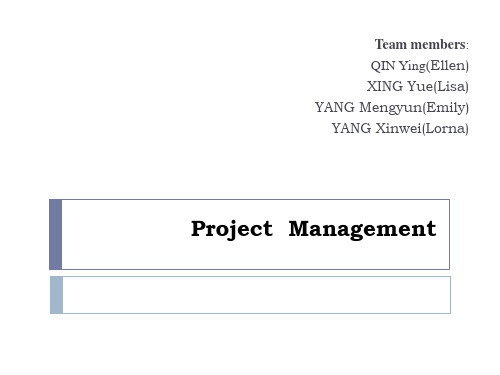
Contrast
Adjustment
2.3 Identify project leadership requirements and qualities
Problems
Woman
Hybrid
organizations More than one manager Seniority matrix
Project manager
Personality and the ability to motivate people Perceptiveness Gather information General knowledge and current awareness Seniority Support, cooperation and training
The project schedule is a calendar that links the tasks to be done with the resources that will do them. Before a project schedule can be created, the project manager must have a work breakdown structure, an effort estimate for each task, and a resource list with availability for each resource. If these are not yet available, it may be possible to create something that looks like a schedule, but it will essentially be a work of fiction. A project manager’s time is better spent on working with the team to create a WBS and estimates than on trying to build a project schedule without them. The reason for this is that a schedule itself is an estimate: each date in the schedule is estimated, and if those dates do not have the buy-in of the people who are going to do the work, the schedule will almost certainly be inaccurate.
工程管理专业英语 第2课教学文稿

因此,图2-1中的显示反映了项目管理框架演变的唯一来源。
6
第六段
Specifically, project management in construction encompasses a set of objectives which may be accomplished by implementing(实施) a series of operations subject to resource constraints.
5
For example, computer-based information system and decision support systems are now commonplace tools for general management.
例如,计算机信息系统和决策支持系统是现在管理的一般工 具。
一般来说,项目管理是区别于一般以任务为导向项目性质的 企业管理。
A project organization will generally be terminated when the mission is accomplished.
项目组织一般是任务完成时项目便终止。 According to the Project Management Institute, the discipline of
Project Management 课件(part2)
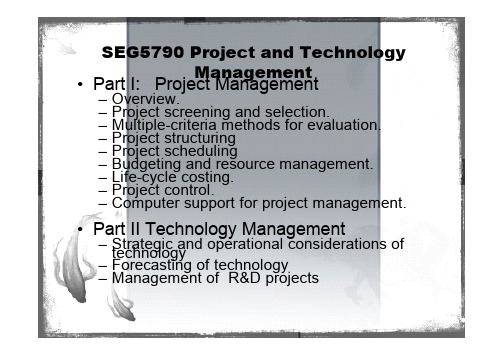
SEG5790 Project and TechnologyManagement•Part I: Project Management–Overview.–Project screening and selection.–Multiple-criteria methods for evaluation.–Project structuring–Project scheduling–Budgeting and resource management.–Life-cycle costing.–Project control.–Computer support for project management.•Part II Technology Management–Strategic and operational considerations oftechnology–Forecasting of technology–Management of R&D projectsChapter 3. Multiple-criteria Methods forProject Selection§3.1 Project selection by using utility functions§3.2 Project selection under multiple criteria§3.1 Project selection by using utilityfunctions•Suppose you are asked to choose between two lotteries, L1 and L2, asfollows:• If you choose L1, you are guaranteed to get $10,000.• If you choose L2, your expected return is $15,000.• Which lottery would you like to choose ?L2L11/21/21$30,000$0$10,000§3.1 Project selection by using utilityfunctions• Although L2 has a larger expected return than L1, many people prefer L1 to L2.• The reason is, L1 offers the certainty to win.• In other words, we prefer L1 to L2, since L1 involves less risk than L2.L2L11/21$30,000$0$10,000How to measure the risk ?•Different people have different perception on risk.•Some people may be more risk averse, but some people may be more risk seeking.•How to measure the risk ? And how to evaluate and represent the degree of your acceptance to risk, if you are the decision maker ?•Your attitude toward risk will affect your decision to choose a project proposal.•Utility theory allows one to build his utility function to represent his attitude toward risk, and therefore to make the decision which he thinks right in situations involving uncertainties.Utility functions•Our goal is to determine a method that a person can use to choose between lotteries (alternatives) involving risks.•Suppose that she must choose to play L1 and L2 but not both.•We write– L1 i L2 if she is indifferent between L1 and L2.– L1 p L2 if she prefers L1 to L2.– L2 p L1 if she prefers L2 to L1.•We also say that L1 and L2 are equivalent lotteries, ifL1 i L2 .U (M )M M MU (M )U (M )(a ) Risk averse (b ) Risk seeker (c ) Risk neutral Utility functionsUtility functions•For a given lottery L=(p1, r1; p2, r2; …; p n, r n), define the expected utility of the lottery L, written E(U for L), byi=nE(U for L)= Σ p i u(r i).i=1•Fundamental Property ofUtility Function: Fundamental Property of Utility Function:Two lotteries are indifferent if they have the same expected utility.An approach to Generate utilityvalues1)Given three monetary values: M1, X, M2 (M1 < X < M2). Let u (M1) = 0, u (M2) = 1. Find u (X).2)Choose p so that the following two lotteries are indifferent :a. Get X with probability 1.b. Get M2 with probability p and M1 with probability (1-p ).Then u (X) = p . (Think about why ? )L2L1p 1-p1M2X M1§3.1 Project selection by using utilityfunctions•Example -- How to rank the following lotteries:L4L10.50.021-$10,000$0$10,000L31$00.98L20.5$500$30,000§3.1 Project selection by using utilityfunctions•The utility theory suggests to rank these lotteries as follows:–(1) Identify the most favorable ($30,000) and theleast favorable (-$10,000) outcomes that canoccur.–(2) For all possible outcomes r i (r1=$10,000,r2=500, and r3=$0), the decision maker is askedto determine a probability p i such that she isindifferent between:p i$30,0001r i1-p i-$10,000§3.1 Project selection by using utilityfunctionsSuppose that for r1=$10,000, the decision maker is indifferent between:0.90$30,0001$10,0000.10-$10,000§3.1 Project selection by using utilityfunctionsFor r2=$500, the decision maker is indifferent between:0.60$30,0001$00.40-$10,0000.62$30,0001$5000.38-$10,000For r3=$0, the decision maker is indifferent between :§3.1 Project selection by using utilityfunctionsTherefore, we can see:0.50$30,0001$10,0000.50L1L2”(i)0.90$30,0000.10-$10,000L1’0.50$30,0000.50$0L2$30,000-$10,0000.40.6(i)§3.1 Project selection by using utilityfunctions0.50$30,0000.50L2”-$10,000$30,0000.40.6 0.80$30,0000.20-$10,000L2’• • L’’ is a compound lottery.•It yields a chance of 0.5+0.5(0.6) =0.8 at $30,000,and a chance of 0.4(0.6)=0.2 at -$10,000. • Since L2 i L2” and L2” i L2’, we know L2 i L2’.(i)§3.1 Project selection by using utilityfunctions0.02$30,0000.98L4’’-$10,000-$10,0000.380.62 0.6076$30,0000.3924-$10,000L4’(i)1$0L30.60$30,0000.40L3’-$10,000(i)§3.1 Project selection by using utilityfunctions0.6076$30,0000.3924-$10,000L4’0.90$30,0000.10L1’-$10,0000.60$30,0000.40L3’-$10,0000.80$30,0000.20L2’-$10,000• We can see that L1’ p L2’ p L4’ p L3’.• Since L1 i L1’, L2 i L2’, L3 i L3’, and L4 i L4’ , we conclude that L1 p L2 p L4 p L3.§3.1 Project selection by using utilityfunctions•Generally, the utility of the reward r i , written u(r i ), is the number q i such that the decision maker isindifferent between the following two lotteries:Most favorable outcome11- q iLeast favorable outcomer iq i • That is, u(r i ) = q i .• The definition forces u(least favorable outcome)=0and u(most favorable outcome)=1.§3.1 Project selection by using utilityfunctions•So, for our possible payoffs of $30,000, -$10,000, $0, $500, and $10,000, we have: u($30,000)=1, and u(-$10,000)=0.•From 0.90$30,0001$10,0000.10-$10,000we have u($10,000)=0.90.§3.1 Project selection by using utilityfunctions•From:0.60$30,0001$00.40-$10,0000.62$30,0001$5000.38-$10,000• From :we have u($500)=0.62.we have u($0)=0.60§3.1 Project selection by using utilityfunctions•For a given lottery L=(p1, r1; p2, r2; …; p n, r n), define the expected utility of the lottery L, written E(U for L), byi=nE(U for L)= Σ p i u(r i).i=1• Thus, in our example,E(U for L1) = 1(0.9) =0.9E(U for L2) = 0.5(1) + 0.5(0.6) = 0.8E(U for L3) = 1(0.6) =0.6E(U for L4) = 0.02(0) + 0.98(0.62)=0.6076.§3.1 Project selection by using utilityfunctions•From the example above, we can see that:E(U for L)Most favorable outcomeLi’1- E(U for L)Least favorable outcome• So, we know Li p Lj, if E(U for Li) > E(U for Lj)§3.1 Project selection by using utilityfunctions•More specifically,Li p Lj, if and only if E(U for Li) > E(U for Lj)Lj p Li, if and only if E(U for Lj) > E(U for Li)Li i Lj, if and only if E(U for Li) = E(U for Lj)Estimating an individual‘s utilityfunction•(1) We begin by assuming that the least favorable outcome (say, -$10,000) has a utility zero and the most favorable outcome (say, $30,000) has a utility one.•(2) Next we identity the number x1/2 having u(x1/2)=1/2.To determine x1/2, we ask the decision maker (DM) for the number x1/2 that makes her indifferent between:1/2$30,0001x1/21/2-$10,000 Suppose the DM states that x1/2=-$3400.Estimating an individual‘s utilityfunction•(3) Using x1/2 and the least favorable outcome (-$10,000) as the possible outcomes, we can construct a lottery that can be used to determine x1/4 (that is, u(x1/4)=1/4). The point x1/4 must be such that the DM is indifferent between1/2x1/2=-$34001x1/41/2-$10,000Suppose the DM states that x1/4=-$8000. This gives another point on the DM’s utility function.Estimating an individual‘s utilityfunction•(4) We can now use x1/2 and the most favorable outcome ($30,000) as the possible outcomes to construct a lottery that yields x3/4 with u(x3/4)=3/4. Again, the point x4/4 must be such that the DM is indifferent between1/2$30,0001x3/41/2x1/2=-$3400Suppose the DM states that x3/4= $8000. This gives one more point on the DM’s utility function.Estimating an individual‘s utilityfunction•(5) Gradually, we have a number of points:(-$10,000,0), (x1/8, 1/8), (x1/4 , 1/4), …, ($30,000, 1).•(6) The DM’s utility function can be approximated by drawing a smooth curve joining these points. (See below for the example).Chapter 3. Multiple-criteria Methods forProject Selection§3.1 Project selection by using utility functions§3.2 Project selection under multiple criteria§3.2 Project selection under multiplecriteria•In this section, we discuss the extension of utility theory to situations in which more than one attribute (criterion) affects the decision maker’s preferences and attitude toward risk.•When more than one attribute affects a decision maker’s preferences, her utility function is called a multi-attribute utility function.•In the following we restrict our discussion to multi-attribute functions with only two attributes.§3.2 Project selection under multiplecriteria•Suppose a decision maker’s preferences and attitude toward risk depend on two attributes, and letx i=level of attribute i, i=1,2.•Then,u(x1,x2)= utility associated with level x1 and x2.•How can we find a utility function u(x1,x2) such that choosing a lottery or alternative that maximizes the expected value of u(x1,x2) will yield a decision consistent with the decision maker’s preferences and attitude toward risk ?§3.2 Project selection undermultiple criteria•In general, determination of u(x1,x2) (or, in case of n attributes, determination of u(x1,x2,…, x n) is a difficult matter.•However, under certain conditions, the assessment of a utility function can be greatly simplified.§3.2.1 Properties of multi-attributeutility functions •Definition - Attribute 1 is utility independent (ui) of attribute 2 if preferences for lotteries involving different levels of attribute 1 do not depend on the level of attributes 2.§3.2.1 Properties of multi-attributeutility functions•Example - The Wivco Toy Co. is to introduce a new product (a gobot) and must determine the price to charge for each gobot. Two factors (market share and profits) will affect Wivco’s pricing decision. Let:x1 = Wivco’s market sharex2 = Wivco’s profits (million of dollars)§3.2.1 Properties of multi-attribute utilityfunctions •Suppose that Wivco is indifferentbetween: L11/230%, $20L1’11/216%, $2010%, $20• If attribute 1 (market share) is ui of attribute 2 (profit), Wivco would also be indifferent betweenL11/230%, $5L1’11/216%, $510%, $5§3.2.1 Properties of multi-attribute utilityfunctions•In short, if market share is ui of profit, then for any level of profits, a 1/2 chance at a 10% market share and a 1/2 chance at a 30% market share has a certainty equivalent of a 16% market share.§3.2.1 Properties of multi-attributeutility functions•Definition - If attribute 1 is ui of attribute 2, and attribute 2 is ui of attribute 1, then attributes 1 and 2 are mutually utility independent (mui).§3.2.1 Properties of multi-attributeutility functions•Theorem 3.2.1 -- Attributes 1 and 2 are mui if and only if the decision maker’s utility function u(x1,x2) is a multi-linear utility function of the following form:u(x1,x2)=k1u1(x1) + k2u2(x2) +k3u1(x1)u2(x2),where k1, k2 and k3 are constants andu1(x1) and u2(x2) are utility functions of x1 and x2 , respectively.§3.2.1 Properties of multi-attribute utilityfunctions•Let x 1(best) or x 2(best) be the most favorable level of attribute 1 or 2 that can occur. Also, let x 1(worst) or x 2(worst) be the least favorable level of attribute 1 or 2 that can occur.•Definition - A decision maker’s utility function exhibits additive independence if the decisionmaker is indifferent between:L11/2L21/21/21/2x 1(best), x 2(worst)x 1(worst),x 2(worst)x 1(worst),x 2(best)x 1(best), x 2(best)§3.2.1 Properties of multi-attribute utilityfunctions•Corollary 3.2.1 -- If attributes 1 and 2 are mui and the decision maker’s utility function exhibits additive independence, then k3=0 and u(x1,x2)=k1u1(x1) + k2u2(x2).§3.2.1 Properties of multi-attribute utilityfunctions •Justification:–We can scale u1(x1) and u2(x2) so that u1(x1(best))=1,u1(x1(worst))=0, u2(x2(best))=1, and u2(x2(worst))=0.–So u(x1,x2)=k1u1(x1) + k2u2(x2) + k3u1(x1)u2(x2) implies: u(x1(best), x2(best))= k1 + k2 + k3, u(x1(worst),x2(worst))=0,u(x1(best), x2(worst))= k1, u(x1(worst), x2(best))= k2.–Then additive independence implies that(1/2)(k1 + k2 + k3)+(1/2)(0)=(1/2) k1 +(1/2) k2This gives us k3 =0.§3.2.2 Assessment of multi-attributeutility functions•We have known that, if attributes 1 and 2 are mui, then u(x1,x2)=k1u1(x1) + k2u2(x2) + k3u1(x1)u2(x2).•Now the question is, how can we determine u1(x1),u2(x2), k1, k2 and k3, so as to determine u(x1,x2) ?•To find u1(x1), u2(x2), we can use the technique for assess single-attribute utility functions as introduced in §3.1.•To find k1, k2 and k3, we begin by rescaling u1(x1), u2(x2) and u(x1, x2) so thatu(x1(best), x2(best))=1, u(x1(worst), x2(worst))=0,u1(x1(best))=1, u1(x1(worst))=0,u2 (x1(best))=1, u2(x2(worst))=0.§3.2.2 Assessment of multi-attributeutility functions•Now, u(x 1, x 2)=k 1u 1(x 1) + k 2u 2(x 2) +k 3u 1(x 1)u 2(x 2) yieldsu(x 1(best), x 2(worst))= k 1(1)+ k 2(0)+ k 3(0)= k 1•Thus, k 1 can be determined from the fact that the decision maker is indifferent between L2L11- k 11x 1(worst),x 2(worst)x 1(best), x 2(worst)k 1x 1(best), x 2(best)§3.2.2 Assessment of multi-attributeutility functions•Similarly, u(x 1, x 2)=k 1u 1(x 1) + k 2u 2(x 2) + k 3u 1(x 1)u 2(x 2) yieldsu(x 1(worst), x 2(best))= k 1(0)+ k 2(1)+ k 3(0)= k 2•Thus, k 2 can be determined from the fact that the decision maker is indifferent between L2L11- k 21x 1(worst),x 2(worst)x 1(worst), x 2(best)k 2x 1(best),x 2(best)§3.2.2 Assessment of multi-attributeutility functions•To determine k 3, observeu(x 1(best), x 2(best)) = u 1(x 1(best))=u 2 (x 1(best))=1. •So, from u(x 1, x 2)=k 1u 1(x 1) + k 2u 2(x 2) + k 3u 1(x 1)u 2(x 2), we have1= u(x 1(best), x 2(best)) = k 1(1)+ k 2(1)+ k 3(1)= k 1 + k 2+ k 3•Thus, k 3= 1- k 1 - k 2•Of course, if the decision maker’s utility function exhibits additive independence, then k 3= 0.§3.2.2 Assessment of multi-attributeutility functions•The procedure to assess a multi-attribute utility function:–Step 1. Check if attributes 1 and 2 are mui. If yes, go to Step 2. (If no, see Keeney and Raiffa, DecisionMaking with Multiple Objective, Wiley, Section 5.7,1976).–Step 2. Check for additive independence.–Step 3. Assess u1(x1) and u2(x2).–Step 4. Determine k1, k2 and (if there is no additiveindependence) k3.–Step 5. Check if the assessed utility function is reallyconsistent with the decision maker’s preferences. Todo this, set up several lotteries and use the expectedutility of each lottery to rank the lotteries. If theassessed assessed utility function is consistent withthe decision maker’s preferences, the ranking underthe assessed utility function should be closelyassemble the decision maker’s ranking of lotteries.§3.2.2 Assessment of multi-attributeutility functions•Example 1a - Assume the current year is 1998. Fruit Computer Company is certain that during the next year 1999 its market share will be between 10 and 50 percent of the microcomputer market. Fruit is also sure that its profits during 1999 will be between $5 million and $30 million. Assess Fruit’s multi-attribute utility function u(x1, x2), wherex1 = Fruit’s market share during 1999x2 = Fruit’s profits during 1999 (in millions of dollars)§3.2.2 Assessment of multi-attributeutility functions•Step 1 - We begin by checking for mui. To check if attribute 1 is ui of attribute 2, we set x2 at different levels, and see whether the lottery w.r.t. x1 is affected or not. Similar experiments can be conducted to check if attribute 2 is ui of attribute 1. Assume that we have found that in this example attributes 1 and 2 are (at least approximately) mui.§3.2.2 Assessment of multi-attribute utility functions •Step 2 - To check for additive independence. We must determine if Fruit is indifferentbetweenL11/2L21/21/21/250%, $510%, $510%, $3050%, $30• Suppose that Fruit is not indifferent between these lotteries. Then Fruit’s utility function will not exhibit additive independence.• We now know that u(x 1, x 2) takes the following form: u(x 1, x 2)=k 1u 1(x 1) + k 2u 2(x 2) + k 3u 1(x 1)u 2(x 2).§3.2.2 Assessment of multi-attributeutility functions•Step 3 - We now assess u1(x1) and u2(x2). Suppose we obtain the results as shown in the following figures.。
第六章_Project schedule management_(第二部分)项目管理英文第六版

• The detail durations are estimated. • These estimates are then aggregated into a total quantity for
each of the activity’s durations.
9
Duration estimates
• Duration estimates may include some indication of the range of possible results.
• For example:
– A range of 2 weeks ±2 days, which indicates that the activity will take at least 8 days and not more than 12 (assuming a 5-day work week); or
• Parametric estimating uses a statistical relationship between historical data and other variables (e.g., square footage in construction) to calculate an estimate for activity parameters, such as cost, budget, and duration.
Chapter 2 The Project Management context and Processes
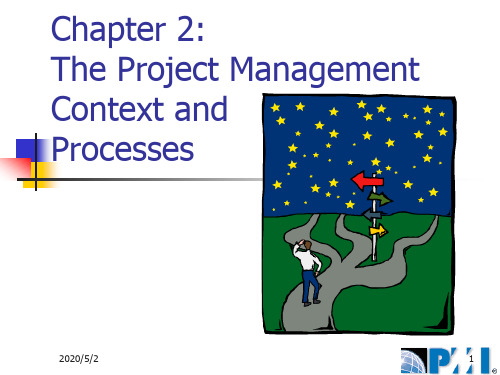
收尾 15% 产品最终审查 接收 结算 转交产品责任 评估
结果文档化 重新分配资源
2020/5/2
10
Product Life Cycles
Products also have life cycles The Systems Development Life Cycle
2020/5/2
11
Sample SDLC Models
Waterfall model: has well-defined, linear
stages of systems development and support
Spiral model: shows that software is
developed using an iterative or spiral approach rather than a linear approach
project phases
Project phases vary by project or
industry, but some general phases include
concept development implementation Close-out
2020/5/2
8
Phases of the Project Life Cycle
(SDLC) is a framework for describing the phases involved in developing and maintaining information systems
Typical SDLC phases include planning, analysis,design,implementation, and support
系统集成项目管理工程师教程第三版第二章
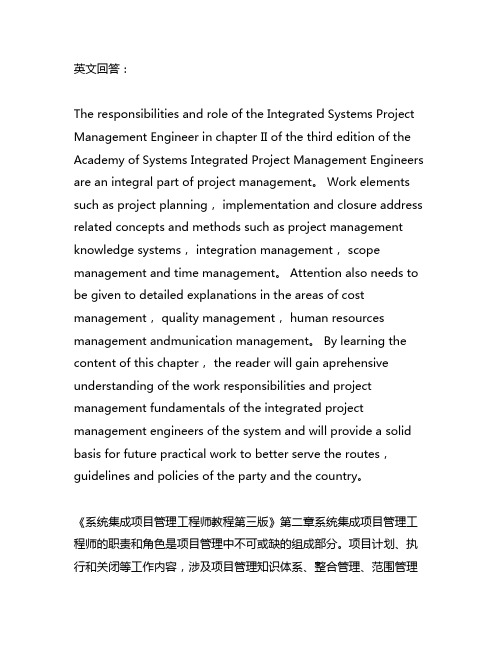
英文回答:The responsibilities and role of the Integrated Systems Project Management Engineer in chapter II of the third edition of the Academy of Systems Integrated Project Management Engineers are an integral part of project management。
Work elements such as project planning, implementation and closure address related concepts and methods such as project management knowledge systems, integration management, scope management and time management。
Attention also needs to be given to detailed explanations in the areas of cost management, quality management, human resources management andmunication management。
By learning the content of this chapter, the reader will gain aprehensive understanding of the work responsibilities and project management fundamentals of the integrated project management engineers of the system and will provide a solid basis for future practical work to better serve the routes,guidelines and policies of the party and the country。
《项目管理概论2》PPT课件

第四节 现代项目管理知识体系
3.项目时间管理 又叫项目工期进度管理,是有关如何按时完成 项目工作的理论、方法、工具。 4.项目成本管理 又叫项目选价管理,是如何在不超出项目预算 的情况下完成整个项目工作,所需的管理理论、 方法、工具。
2018/11/21
28
第四节 现代项目管理知识体系
1.业务项目和自我开发项目 业务项目是由专业性项目公司为特定的客户或业 主所完成的项目。自我开发项目是项目团队为自己企 业或组织所完成的各种开发项目。 2.企业项目、政府项目和非盈利机构的项目 企业项目是由企业提供投资或资源,并作为项目业 主或顾客。政府性项目是由国家或地方政府提供投资 或资源,并作为业主或顾客,而非盈利机构的项目是 指像学校、社团、社区等组织提供投资或资源,为满 足这些组织的需要而开展的各种项目。
2018/11/21 19
第三节 项目管理的基本概念
3.独特性 项目管理既不同于一般的生产服务运营管理,也不
同于常规的行政管理,它有自己独特的管理对象(项
目),有自己独特的管理活动,有自己独特的管理方 法和工具,是一种完全不同的管理活动。
2018/11/21
20
第三节 项目管理的基本概念
4.集成性 项目管理要求必须充分强调管理的集成性特性。例 如,对于项目工期、造价和质量的集成管理,对于项 目、子项目的集成管理等等。
1.工作性质与内容的不同 “运营” (operation) 中存在着大量的常规性、不断 重复的工作或劳动,而“项目”中则存在较多创新性 的一次性工作或劳动。 2.工作环境与方式的不同 “运营”工作的环境是相对封闭和相对确定的,而 “项目”的环境是相对开放和相对不确定的。
2018/11/21 23
project management-项目管理课后题及答案2

1.A private sector owner has more flexibility in designer and builder and builder selection and choice of delivery method than does a public owner.True or false? T私人部门拥有者的设计者和建造者和建设者的选择和选择的送货方式的更多的灵活性比不公开的所有者2.Both public and private sector owners hire architects first;the architects are responsible for hiring appropriate engineers.True or false?F公共和私营部门的业主至上聘请建筑师,建筑师是负责招聘的工程师合适3.Although a designer’s and a constructor’s responsibilities on a project differ,the financial,marking,and personnel functions of their home offices are relatively similar.True or false?T虽然一个项目一个设计师的和构造的不同职责,他们家办事处的财务,标记和人事职能都比较相似4.Which project participant is responsible for establishing the project objective? Aa.The ownerb.The architectc.The engineerd.The constructione.All of the above5.A constructor may be brought into a project before the design to provide early estimating,scheduling,and project control support,True or false? F一个构造函数可以被带入一个项目设计之前提供早期估计,调度和项目控制的支持窗体底端6.Who is responsible for contracting for subcontractor services on a project? Da.The field engineerb.The estimatorc.The superintendentd.The purchasing agente.All of the above7.Who is responsible for the correct positioning of a building on a site?Ca.The structural engineerb.The surveyorc.The civil engineerd.The constructore.None of the above8.Which project participant is responsible for the physical construction of the project?Ca.The architectb.The engineerc.The constructord.The construction tradese.None of the above9.Through their respective trade associations,material supplier often provide standards that may be incorporated into a project’s technical specifications.True or false? T通过其各自的贸易协会,材料供应商通常提供了可以结合到一个项目的技术规格标准10.Which of the following professions does not require state registration? Da.Architectureb.Constructionc.Engineeringd.Surveyinge.All of the aboveExercises1.Identify a new project that has been constructed in your area.Who was the lead design firm?Identify the subconsultants/designers hired by this firm.Identify the training and/or registration of the key designers that were used on the project.2.Identify the local professional architectural,engineer,and construction chapters that exist in your area.Contact one of these societies,get copies of their publications,invite a guest speaker to your class,and/or attend a meeting.3.Visit a job site and identify the trades that are presently working there.Write up a description of work for each trade.Is the job union or nonunion?。
项目经理教程第二周
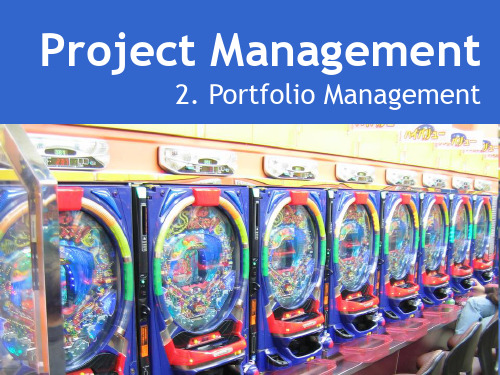
Strategic Planning Identifying IT Projects
Project Proposals Project Selection Methods Applying a Selection Model
Project Selection Project Success
Strategic Planning Identifying IT Projects
S
W
O
T
Positive
Negative
S
W
O
T
T
O
External
W
S
Internal
Positive
Negative
S
W
Internal
External
O
T
Positive
Negative
S
W
Internal
External
O
T
Review Mission Set (SMART) Goals Develop Strategies Align Strategies to goals Implement Strategies through projects
Relevant
Time-bound
Minor Terms Significant[3], Stretching[3], Simple Meaningful[3], Motivational[3], Manageable Agreed, Attainable[6], Assignable[2], Appropriate, Actionable, Action-oriented[3] Realistic[2], Results/Results-focused/Results-oriented[6], Resourced[7], Rewarding[3] Time framed[2], Timed, Time-based, Timeboxed, Timely[6][5], Timebound, Time-Specific, Timetabled, Trackable
项目管理 Project Time Management-2要点
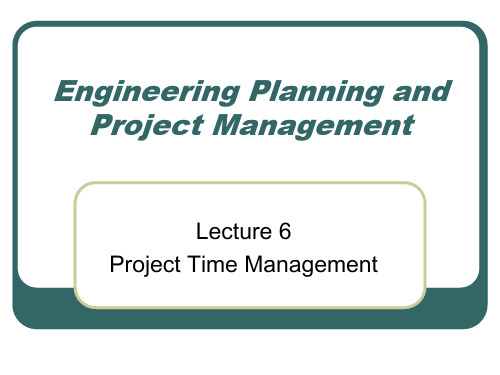
Project Scheduling
First you need to generate the Work Breakdown Structure (WBS) for the project as demonstrated . From the WBS, you need to generate the Network Activity Diagram for the project – commonly referred to as the Network Diagerminology simplified
Scope – The work content and products of a project. Work Breakdown Structure (WBS) – A task oriented family tree of activities that organizes, defines, and graphically displays the total work to be accomplished in order to achieve the final objectives of the project. Work Package – A deliverable at the lowest level of the work breakdown structure. Project Network Diagram – Any schematic display of the logical relationships of project activities. Path – A sequence of activities defined by the project network logic. Early Start Date (ES) – The earliest possible date on which the uncompleted portions of an activity can be completed. Late Start Date (LS) – The latest possible date that an activity may begin without delaying a specified milestone.
工程管理专业英语 第2课
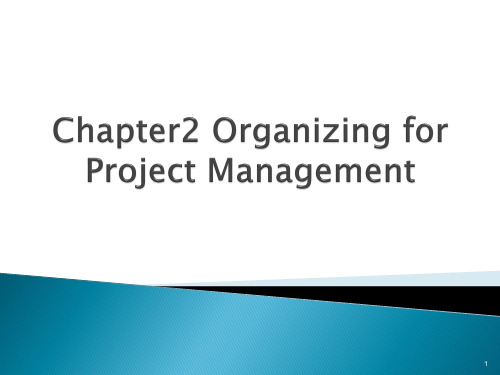
5
The basic ingredients for a project management framework may be represented schematically in Figure2-1. 项目管理框架最基本的因素由图2-1所示。 A working knowledge of general management(综合、一般) and familiarity with the special knowledge domain related to the project are indispensable. 一般管理应用知识和(对)项目相关的专业知识领域(的熟知)是不可 缺少的。 Supporting disciplines(学科) such as computers science and decision science may also play an important role. 例如计算机科学和决策科学之类的支持学科也许也扮演一个重要角色。 In fact, modern management practices and various special knowledge domains have absorbed various techniques or tools which were once identified only with the supporting disciplines. 实际上,现代管理实践与各专业知识领域已经吸收(应用)了各种不同 的技术和工具,而这些技术和工具曾一度仅仅被视作属于支持性学科的 范畴。
4
By contrast, the general management of business and industrial corporations assumes a broader outlook with greater continuity of operation. 与此形成对照,一般的工商企业的一般管理更广泛地着眼于业务更 佳的连续性。 Nevertheless, there are sufficient similarities as well as differences between the two so that modern management techniques developed for general management may be adapted for project management. 不过,二者之间也有足够的相似性和差异,以便项目管理适应为一 般管理开发的现代管理技术。
【管理课件】(2)PROJECT MANAGEMENT CONTEXT AND PROCESSES
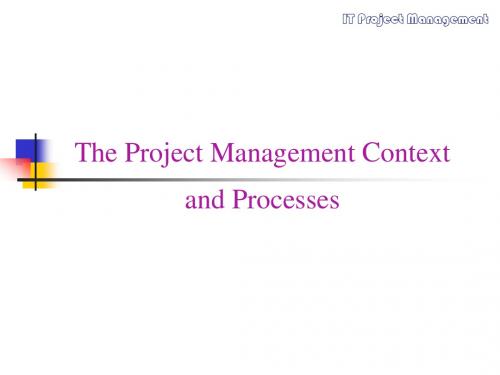
Context and Processes
6
IT Project Management
Three Sphere Model for Systems Management
Senior managers and project managers must identify key business, technological and organizational issues related to each project in order to do what is best for the entire organization.
A project life cycle is a collection of project phases
Context and Processes
8
IT Project Management
Project Phases and the Project Life Cycle
Project phases vary by project or industry, but some general phases include
Context and Processes 5
IT Project Management
Projects Cannot Be Run In Isolation
Projects must operate in a broad organizational environment. If project are run in isolation, it is unlikely that those projects will ever truly serve the needs of the organization.
Modern Project Management Introduction V2.1 for presentation
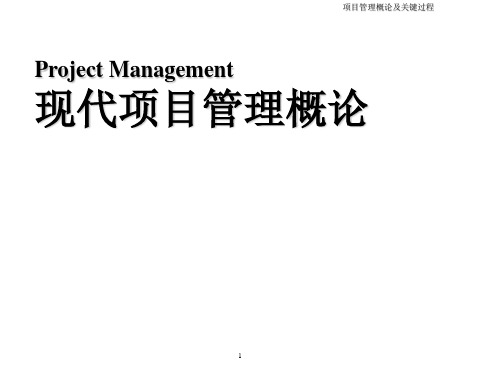
项目管理概论及关键过程
发布项目书 发布项目一览表 设置责任矩阵 设立沟通计划
20
四、制定项目计划
项目管理概论及关键过程
21
项目管理概论及关键过程
项目范围管理 Scope Mgt.
• 界定项目的范围并且在此基础上进行管理。包括:
➢ 范围规划 ➢ 范围定义 ➢ 建立WBS ➢ 范围验证 ➢ 范围控制
项目管理概论及关键过程
成本 时间
8
项目成功五要素
项目管理概论及关键过程
目标明确 控制范围
项目计划
良好沟通 管理支持
9
项目管理概论及关键过程
PMI项目管理知识体系
• 项目管理过程(依据管理活动划分):
➢项目启动过程 ➢项目计划过程
I.起始过程
II.计划过程
➢项目实施过程 ➢项目控制过程
IV.控制过程
➢ 5大过程组:启动、规划、执行、监控、收尾。 ➢ 42个过程、129个工具与技术、75个可交付成果。
• 需要科学与艺术的完美结合
4
项目集成管理系统
项目管理概论及关键过程
5
项目管理概论及关键过程
项目管理的目标是什么?
多快 好 省
6
项目管理概论及关键过程
Balance triple constraint in reason
开始
11
完成
项目管理概论及关键过程
项 目 管 理 流 程 概 览
12
项目管理概论及关键过程
我国建设工程项目管理(运行商)
电 信 工 程 基 本 建 设 程 序
13
PMI 项 目 管 理 知 识 体 系
2008
项目管理
项目管理概论及关键过程
项目管理Lecture2
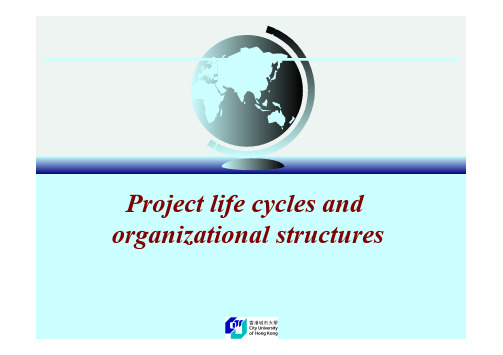
Organisational structures
Authority, Responsibility & Accountability
authority - power granted to individuals so that they can make decisions for others to follow ! responsibility - obligation incurred by individuals in their role or position in the formal organisation with regard to the performance of certain assignments ! accountability - state of being totally answerable for the satisfactory completion of a specific assignment Q. Differentiate authority, responsibility and accountability in the context of functional management and project management?
Project life cycles and organizational structures
Typical management functions
✦ ✦ ✦ ✦ ✦
Planning Organising Staffing Directing Controlling
Project characteristics specific goal/objectives uniqueness project life cycle interdependency conflicts
- 1、下载文档前请自行甄别文档内容的完整性,平台不提供额外的编辑、内容补充、找答案等附加服务。
- 2、"仅部分预览"的文档,不可在线预览部分如存在完整性等问题,可反馈申请退款(可完整预览的文档不适用该条件!)。
- 3、如文档侵犯您的权益,请联系客服反馈,我们会尽快为您处理(人工客服工作时间:9:00-18:30)。
• Operational planning:
– Based on routines, known systems, and accepted processes. – Planning based on reactive measures to maintain status quo.
• Strategic planning:
system.
• Regulated compliance – new workplace for OH&S compliance. • Cost efficiencies – assessment of product delivery systems.
10
What elements are encapsulated in the definition of projects that infers suitability for strategic functions?
– Determination of future pathways to specified goals – Planning based on proactive measures requiring innovation and risk.
8
Your study: What aspects are routine (operational)? What aspects are novel (strategic)? How does your approach to each change?
1. Review and define the organisational mission.
2. Set long-range goals and objectives.
3. Analyze and formulate strategies to reach objectives.
4. Implement strategies through projects.
project selection.
4. Explain using a diagram a method used to create project portfolios.
5
Topic readings
• Textbook Chapter 2
• Brown, K. A., & Hyer, N. L. (2010). Managing Projects: A Team-based Approach. New York: McGraw-Hill. Chapter 3 (pp. 59-84)
MGW2700 PROJECT MANAGEMENT
Topic 2 Alignment and selection
Seminar outline
1. Review last week
2. Learning activities
3. Project ideas
4. Lecture week 2
a. Aligning projects and organisations
6
Linking projects in organisation - effort
Strategic Plan Portfolio Program Project Stage
Task
Work Package Level of Effort
7
Strategic planning versus operational planning
12
The Strategic Management Process: A refresher • Strategic Management
– Focuses the future direction taken by the firm.
• Responding to changes in the external environment—requires environmental scanning • Allocating scarce resources of the firm to improve its competitive position—internal action programs
MY PROJECT IDEA IS
...............................................................................................
Project Management: Principles, Processes and Practice - Stephen Hartley © 2008
EXHIBIT 2.1
Video
Project Proposals
• Sources and Solicitation of Project Proposals
– Within the organization – Request for proposal (RFP) from external sources (contractors and vendors)
b. Project selection models
5. Next week
2
Last week
Project management fundamentals
1) Project definition - achieve objectives by coordinating resources within a specified period. 2) Four management functions applied to projects – planning, leading, organising and controlling.
Strategic plan – examples where project management may be suitable (LO1)
• Competitive activity – development of a new product. • Customer advantage – analysis of service delivery
• Evaluated using a transparent a selection process that accounts for organisational strategy • An ongoing portfolio of projects are selected and evaluated using the process • Project are validated and compared using best available evidence including application of selection models.
• Managing the Portfolio
– Senior management input – The priority team (project office) responsibilities
Project selection models
• Select the most suitable projects with regard to strategic objectives
19
Comparing project options
Choosing which projects to implement (project portfolio) when constrained by resources:
Examples of factors that may be considered in the selection process:
4
Topic 2 Alignment and selection
Following completion of this topic you should be able to:
1. Provide three reasons why projects are more likely to be linked or aligned to organisational strategy as opposed to operational planning. 2. Describe using an example one financial model used for project selection. 3. Describe using an example one non-financial model used for
5. Evaluate projects with regard to strategic effectiveness.
Strategic ManaE 2.1
Strategic Objectives
S Specific - Clear as to purpose
• Ranking Proposals and Selection of Projects
– Prioritizing requires discipline, accountability, responsibility, constraints, reduced flexibility, and loss of power
